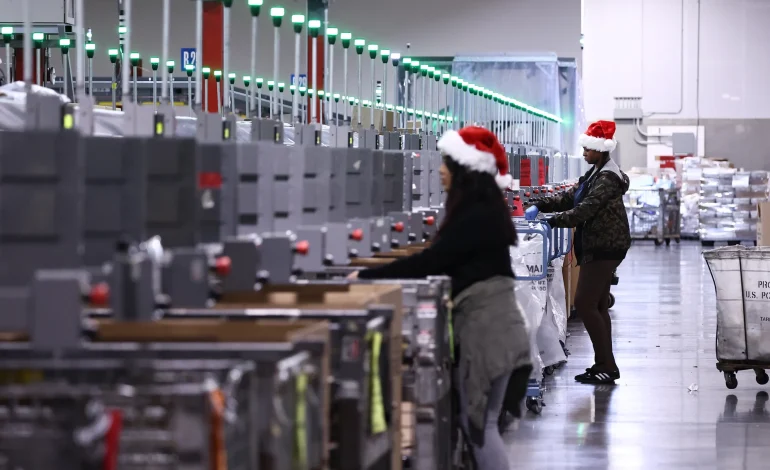With input from CNBC and Quartz.
For decades, Black Friday was retail’s biggest, wildest, most chaotic day of the year — the kind of event where shoppers lined up in the freezing dark, sprinted into stores at 5 a.m., and wrestled over TVs stacked like fortresses in the electronics aisle.
Today? Not so much.
Black Friday is still big, but it’s no longer that day — the one defined by packed parking lots, screaming crowds, and once-in-a-year deals. Now it’s part of a months-long blur of online discounts, endless promo emails, and “Black Friday starts now!” banners that go up before you’ve even carved the Halloween pumpkin.
And many experts say it just doesn’t hit the same anymore.
“The integrity of the event is pretty much gone,” says Mark Cohen, former CEO of Sears Canada and longtime retail analyst. “Back in the day, a Black Friday price was the best you could ever find… never to be seen again. Today, the closer you get to the holiday, the better the deal tends to be.”
Foot traffic on Black Friday, once the stuff of retail legend, has basically stalled out. More people now shop online than in stores — a trend that’s been growing for six years straight, according to the National Retail Federation.
Retailers like Walmart, Target, Macy’s and Kohl’s have adapted by:
- Moving deals earlier (some start in October);
- Spacing out promotions over multiple events;
- Staying closed on Thanksgiving while still pushing online sales;
- Turning Cyber Monday into a week-long sequel.
“The day that used to be about lining up at 4 a.m. has been stretched into weeks,” says Denish Shah of Georgia State University. “And now most people just shop from their couch.”
Even with strong store visits compared to an average day, foot traffic hasn’t meaningfully grown since 2021, analytics firm Placer.ai shows. And spending over the Turkey 5 — the five-day shopping window from Thanksgiving to Cyber Monday — has fallen for two years in a row.
Consumers plan to spend 4% less this Thanksgiving weekend, per Deloitte. Millennials and Gen X increasingly check out early. Gen Z is lukewarm. Boomers? Mostly unchanged, but not saving the day.
In short: the frenzy is fading.
In its heyday, Black Friday was a year-long planning marathon for retailers.
“You had to convince a vendor to give you a massive discount so you could offer something truly irresistible,” Cohen said. “It took enormous effort.”
But as the holiday became too successful, retailers stretched the magic until it snapped:
- Stores opened earlier — then on Thanksgiving;
- Deals expanded from a handful of items to entire departments;
- Promotions crept back from Friday to Thursday to Wednesday to… October;
- Online shopping exploded;
- Doorbusters lost their shock value.
“In other words,” Cohen says, “to sustain the ride, they started to dilute it.”
Retailers also struggled with staffing huge one-day surges, pushing them to spread sales across longer periods. Consumers, meanwhile, learned to wait for even better deals later in the season — or just shop earlier to split purchases across multiple paychecks.
Depends who you ask.
Online shopping’s rise — supercharged by the pandemic — means retailers don’t need to go all-out in person anymore. And heavy discounting throughout the year has trained consumers to question whether a “deal” is actually a deal.
Sonia Lapinsky of AlixPartners says many shoppers no longer trust the hype.
“There’s rampant discounting before, during and after Black Friday,” she said. “Some promotions are really just rolling back prices retailers recently raised. Consumers are tired and skeptical.”
Many brands, including Gap, Levi’s and Under Armour, launched Black Friday deals on Thanksgiving — and the discounts weren’t any better than earlier in November.
“The idea of urgency is kind of goofy and gone,” Cohen said. “A lot of these deals are basically scams.”
Black Friday’s decline in 2025 is a perfect storm of new consumer habits, new tech and new retail strategy.
Here are the four big buzzkillers reshaping the shopping season:
1. AI Is Changing How People Shop
Data from Datos shows AI-driven product discovery (think recommendations from ChatGPT-like platforms) doubled year over year. Over half of AI queries leading to Amazon involve purchase intent.
2. Dynamic Pricing Eats Doorbusters
Online retailers constantly tweak prices now, making surprise one-day mega-deals unnecessary. Discounts are rolled out earlier and longer.
“Shoppers no longer have to wait for one day,” says retail analyst Greg Zakowicz.
3. Stores Are Now Fulfillment Hubs
Automation and smarter logistics mean retailers don’t need giant in-store crowds.
“Physical stores have become fulfillment hubs, not battlegrounds,” says Sudip Mazumder from Publicis Sapient.
4. Loyalty Programs Stretch Out the Season
Brands now create their own Black Fridays — loyalty events like “Insiders Week” that drive bigger sales than the traditional day.
“It’s Amazon Prime logic applied to everyone,” says Charlie Casey of LoyaltyLion.
Not yet. But its dominance is definitely cracking.
Only 20% of shoppers now plan to start their holiday shopping on Black Friday weekend, per Cordial. Most start early, wait for deeper discounts, or shop last minute.
“Black Friday’s dominance has waned,” says Rob Garf of Cordial. “Retailers and consumers are in a game of chicken — each waiting for the other to blink.”
Retail experts say Black Friday still matters — but as part of a much longer, more digital, more personalized sales cycle.
“The excitement has shifted,” says Bess Devenow of Vantage. “The value-hunting spirit is still alive. It just doesn’t all happen in one day anymore.”
Ben Hussey of Katana Cloud Inventory sums it up best:
“It no longer fits how consumers shop. But it’s not irrelevant — it’s simply evolved.”
So farewell, doorbuster stampedes. Black Friday didn’t die — it just became a season instead of a day.









The latest news in your social feeds
Subscribe to our social media platforms to stay tuned